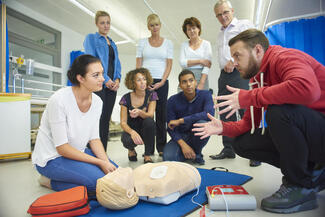Continuing Education Requirements - EMR, EMT, AEMT, Paramedic
Vermont EMS practitioner license renewal requirements mirror those of the National Registry of EMTs. Most of Vermont’s EMS practitioners hold a National Registry of EMTs certification and meet Vermont’s continuing education requirements by renewing that certification. Current practitioners who never held NREMT certification must also meet the NREMT renewal requirements and document their training on their Vermont license renewal application.
Continuing Education Requirements - Vermont Emergency First Responder
To renew a VEFR certification, a person must maintain their American Heart Association Heartsaver First Aid CPR/AED certification (or equivalent) and complete continuing education on the following topics:
- Workforce Safety and Wellness - 2 hours
- EMS System Communications - 1 hour
- Medical/Legal and Ethics - 1 hour
NREMT - National Continued Competency Program
Vermont has used the NREMT’s National Continued Competency Program (NCCP) as its model for continuing education since July 2015. The foundation of this program is continuous quality improvement, lifelong learning and individual self-assessment.
The NCCP started in 2010 when a multi-disciplinary task force consisting of representatives from major regulatory, medical oversight and operational components of EMS met to consider revisions to the NREMT recertification process. The result is a program that evolves over time and allows states, the local EMS community and individual EMS practitioners to choose topics that are most relevant to their educational needs.
There are three components of the National Continued Competency Program. Half of the hours are determined by the NREMT, a quarter are chosen at the State and Local levels and the remaining quarter are chosen by each EMS practitioner based on their interests and self-assessment of educational needs.
The National Registry of EMTs has produced educational guides for each level:
National Requirements of the National Continued Competency Program
The national requirement topics of the National Continued Competency Program are selected by the National Registry of EMTs based on input from EMS researchers, physicians and practitioner stakeholders and are updated every five years. Topics are chosen from evidence-based medicine and scientific position papers aimed at improving patient care, particularly tasks with low frequency but high criticality.
State/Local Requirements of the National Continued Competency Program
A portion of Vermont’s state and local requirement topics are determined by the EMS office based on state-specific training needs. The remaining hours are determined at the district and/or agency level.
Individual Requirements of the National Continued Competency Program
The remaining portion of each EMS practitioner’s continuing education is determined by the practitioner based on their own areas of interest or possible weakness. Any training that relates to the clinical or operational functions of an EMS practitioner at their license level qualifies for continuing education in this section.
The Statewide EMS Protocols represent the work of all 13 District Medical Advisors, numerous stakeholder groups and a multitude of EMS practitioners, agencies and districts across the state. Wherever possible, protocol updates have been guided by the most recent and best evidence-based EMS literature.
EMS Protocol Education
2023 Vermont Statewide Emergency Medical Services Protocols
Ready, Check, Inject
The Ready, Check, Inject program provides a simple, safe and cost-effective alternative to epinephrine auto-injectors and allows trained Emergency Medical Technicians (EMTs) to withdraw epinephrine from a vial and inject the medication intramuscularly. Ready, Check, Inject is not intended to take the place of autoinjectors; epinephrine auto-injectors are still considered the preferred method of medication administration in anaphylaxis.
Equipment Requirements
To administer intramuscular epinephrine at the EMT level, an agency must stock:
- 1 mL vials of 1 mg/1 mL (1:1000) concentration epinephrine
- Larger volume vials and syringes are not allowed at the EMT level
- 1 mL syringes with an accompanying 1-inch intramuscular safety needle
- Ready Check Inject Safety Card
NOTE: Consider separating this specific equipment from other ALS supplies to prevent confusion. Please see the equipment checklist for the complete list of required items.
Training and Credentialing
EMS agencies must credential their EMT level providers to use the new protocol using a two-step process. Providers will watch a narrated Power Point on CentreLearn (individually or as a class) and then complete an agency-led practical training session overseen by the agency’s or district’s training coordinator. Competency must be confirmed by a licensed practitioner at the AEMT or Paramedic level using the skill sheet included in the training program. Documentation of training and competency verification should be kept on file by the agency.
Rapid Sequence Intubation
Rapid Sequence Intubation (RSI) is an advanced airway skill only available to Paramedics with additional training, medical direction oversight and participation in an educational and Continuous Quality Improvement (CQI) program approved by the Department of Health.
For more information about RSI, contact EMS Medical Director Dr. Dan Wolfson.
Training Officer Resources
VT EMS Agency Level Training Officer Guidance Document

